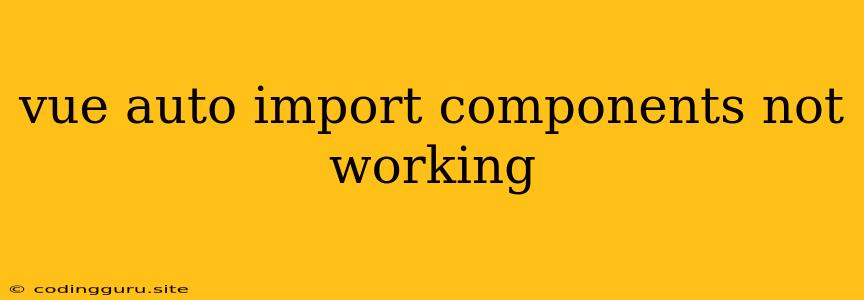Why My Vue Auto Import Components Aren't Working: A Troubleshooting Guide
Auto-importing components in Vue.js can be a huge time-saver, making development smoother and faster. However, when it doesn't work as expected, it can be incredibly frustrating. If you're facing issues with your Vue auto import components not working, don't worry, we've got you covered. This guide will help you troubleshoot and resolve common problems, getting your components working seamlessly again.
Understanding Auto-Import in Vue
Before we dive into troubleshooting, let's briefly understand how auto-import works in Vue.js. It relies on tools like unplugin-vue-components, which automatically registers components within your project, eliminating the need for manual imports in each component.
Common Reasons Why Auto-Import Might Fail
Here are some of the most common reasons why auto-import might not be working as intended:
- Missing Configuration: Ensure that your Vue project is properly configured to use auto-import. This includes installing the necessary plugin and configuring it correctly.
- Incorrect Component Naming: Auto-import relies on consistent naming conventions. Ensure that your component filenames and component names match (e.g.,
MyComponent.vueshould have a<template>tag withname="MyComponent"). - Case Sensitivity: File systems are often case-sensitive. Verify that component file names and import paths match exactly, including capitalization.
- Incorrect Import Path: Double-check your import path, especially if your components are in a nested directory structure.
- Plugin Conflicts: Conflicts between plugins can interfere with auto-import. Ensure that your plugin is properly installed and configured, and it doesn't conflict with other plugins in your project.
- Caching Issues: Sometimes, cached files can prevent changes from taking effect. Try clearing your project's cache or restarting your development server.
Troubleshooting Steps
Here's a step-by-step guide to troubleshoot and fix issues with Vue auto-import components:
-
Verify Plugin Installation:
- Ensure that
unplugin-vue-componentsis properly installed in your project:npm install unplugin-vue-components - If not installed, install it using the above command.
- Ensure that
-
Check Configuration:
- Make sure you have configured
unplugin-vue-componentscorrectly in yourvite.config.jsorvue.config.jsfile:import Components from 'unplugin-vue-components/vite'; import AutoImport from 'unplugin-auto-import/vite'; import { ElementPlusResolver as ElementResolver } from 'unplugin-vue-components/resolvers'; export default defineConfig({ plugins: [ Components({ resolvers: [ElementResolver()], }), AutoImport({ imports: ['vue', 'vue/macros', 'pinia'], resolvers: [ElementResolver()], }), ], }); - Update the configuration if necessary to include the plugin and its options.
- Make sure you have configured
-
Component Naming Consistency:
- Double-check that your component file names and component names within the
<template>tag are consistent:- Incorrect:
This is MyComponent
- Correct:
This is MyComponent
- Incorrect:
- Double-check that your component file names and component names within the
-
Case Sensitivity:
- Ensure that the component file names and import paths match exactly, including capitalization:
- Incorrect:
- Correct:
- Incorrect:
- Ensure that the component file names and import paths match exactly, including capitalization:
-
Correct Import Path:
- Double-check your import path, especially if components are in a nested directory structure:
- Incorrect:
- Correct:
- Incorrect:
- Double-check your import path, especially if components are in a nested directory structure:
-
Plugin Conflicts:
- If you're using other plugins, verify that they don't conflict with
unplugin-vue-components. - Consult the documentation for other plugins to ensure compatibility.
- If you're using other plugins, verify that they don't conflict with
-
Clear Cache and Restart Server:
- Sometimes, cached files can cause issues. Clear your project's cache and restart your development server:
- For Vite:
npm run clean && npm run build && npm run serve - For Webpack:
npm run clean && npm run build && npm run serve
- For Vite:
- Sometimes, cached files can cause issues. Clear your project's cache and restart your development server:
-
Check for Typos:
- Double-check for any typos in your code, especially in component file names, import paths, and component names.
Example: Resolving Common Auto-Import Issues
Problem: You've installed unplugin-vue-components, but auto-import still doesn't work.
Solution:
- Verify Configuration: Ensure that
unplugin-vue-componentsis correctly configured in yourvite.config.jsorvue.config.jsfile. - Check Naming Conventions: Verify that your component filenames and component names match (e.g.,
MyComponent.vuewith a<template>tag usingname="MyComponent"). - Case Sensitivity: Ensure that file names and import paths are case-sensitive and match exactly.
Problem: You're using a nested directory structure for your components, and auto-import fails.
Solution:
- Double-check the Import Path: Verify that the import path correctly points to the component file.
- Adjust
vue.config.js: If necessary, adjust thetranspileDependenciesoption in yourvue.config.jsfile to include the nested directory structure.
Conclusion
When your Vue auto-import components aren't working as expected, troubleshooting can be a bit of a puzzle. By carefully working through the common reasons and steps outlined in this guide, you should be able to pinpoint the issue and get your components auto-importing correctly again. Remember to check your configurations, naming conventions, and import paths for any potential errors. With a bit of debugging, you'll have your components working seamlessly, saving you valuable development time.
